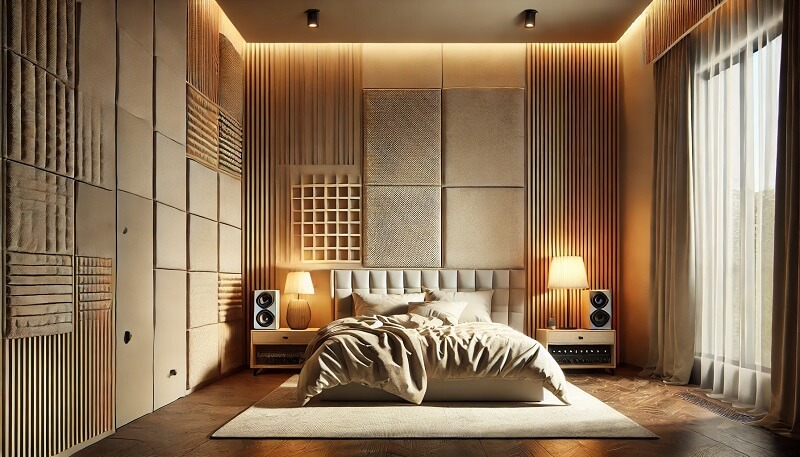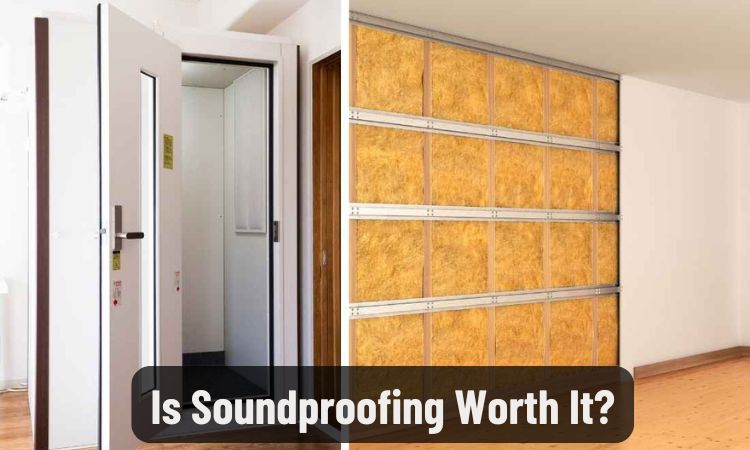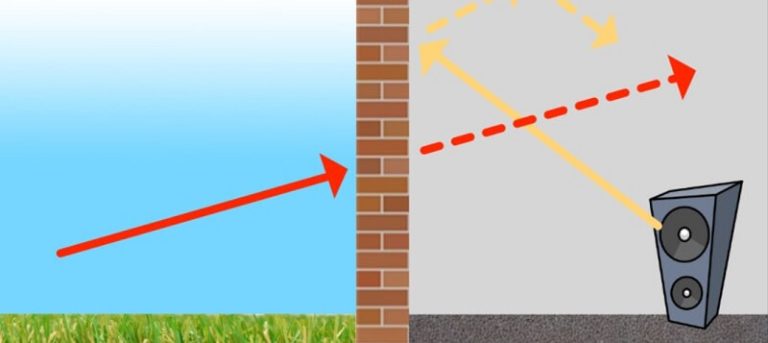
Do acoustic panels help with neighbor or street noise? This is a common question for those seeking peace and quiet in their homes. While acoustic panels are excellent for improving the sound quality within a room, their effectiveness against external noises like neighbor disturbances or traffic is often misunderstood.
This article explores the capabilities and limitations of acoustic panels in dealing with both neighbor and street noise, offering practical advice and solutions for a quieter living space.
How Acoustic Panels Work
Sound Absorption vs. Sound Blocking
Acoustic panels primarily absorb sound, not block it. They’re designed with porous materials that trap sound waves, converting their energy into heat and reducing reverberations within a room.
This improves speech clarity and reduces echoes, creating a more pleasant acoustic environment. However, this mechanism is different from sound blocking, which prevents sound from transmitting through a structure. Sound blocking relies on dense, heavy materials like Mass Loaded Vinyl (MLV) or additional drywall to create a barrier.
While acoustic panels can contribute to a quieter overall environment by minimizing internal reflections, they shouldn’t be relied upon solely to stop noise from entering from outside.
Materials and Design
Acoustic panels are typically made of porous materials like open-cell foam, fiberglass, or mineral wool. These materials are highly effective at capturing sound waves due to their internal structure. Some panels also use recycled materials like denim or cellulose.
The choice of material influences the panel’s absorption characteristics, which are often measured by the Noise Reduction Coefficient (NRC). An NRC of 1 indicates perfect absorption, while 0 means no absorption. Many acoustic panels have NRC ratings between 0.7 and 1.0, indicating they absorb a significant portion of the sound that strikes them.
These panels are available in various shapes, sizes, and colors, allowing for aesthetic integration into any space.
Acoustic Panels for Neighbor Noise
Effectiveness on Shared Wall Noise
While not a complete solution for blocking noise, acoustic panels can help mitigate the impact of low-level neighbor noises, like conversations or the faint sound of a television. By reducing sound reflections within your room, they can make these noises less noticeable and distracting. However, for louder noises like music or parties, acoustic panels alone won’t suffice. For more effective solutions, consider how can I reduce traffic or shared wall noise in bedrooms.
Significant noise reduction from neighbors requires a combination of sound absorption and sound blocking techniques. Research published in the Journal of the Acoustical Society of America indicates that combining porous absorbers (like acoustic panels) with barrier materials provides the best results in reducing noise transmission.
Ideal Applications
Acoustic panels are most effective in situations where the noise is moderate and primarily airborne. For instance, if you can faintly hear your neighbor’s conversations or television, strategically placed acoustic panels can improve the sound quality within your room, making these distractions less bothersome.
However, for impact noises like footsteps or slamming doors, more robust soundproofing solutions are necessary.
Acoustic Panels for Street Noise
Limitations with External Noise
Street noise, especially traffic, often contains low-frequency sounds that are difficult to absorb with standard acoustic panels. These panels are more effective at higher frequencies, meaning the rumbling of trucks or the bass from car stereos can still penetrate. Additionally, since they are designed for interior sound management, they cannot stop noise from entering through windows or gaps in the building structure.
Combining Solutions
To effectively reduce street noise, a multi-pronged approach is essential.
Combining acoustic panels with other soundproofing measures can create a significantly quieter environment. Some effective strategies include:
- Soundproof Curtains: Heavy, multi-layered curtains specifically designed for noise reduction can add an extra layer of sound blocking to your windows. Look for curtains with a high Sound Transmission Class (STC) rating for better performance.
- Double-Glazed Windows: Replacing single-pane windows with double-glazed or triple-glazed units creates an air gap that significantly reduces noise transmission.
Studies have shown that double-glazing can reduce noise by up to 50% compared to single-pane windows.
- Weatherstripping: Sealing gaps around windows and doors with weatherstripping prevents noise leakage and improves overall sound insulation. Even small gaps can significantly compromise soundproofing efforts.
Best Practices for Using Acoustic Panels
Strategic Placement
Optimal placement is crucial for maximizing the effectiveness of acoustic panels.
Focus on areas where sound reflections are most prominent, such as walls opposite windows or near shared walls with neighbors. A common recommendation is to cover approximately 15-20% of the wall surface area with acoustic panels for noticeable improvement. However, the exact amount needed can vary depending on the room’s size, shape, and the specific noise problem you’re addressing.
Combining with Other Materials
For a more comprehensive solution, especially on shared walls, consider installing MLV behind the acoustic panels.
This combination provides both absorption and blocking, creating a more effective sound barrier. Similarly, soundproof inserts or specialized acoustic caulk can seal gaps around windows and doors, further enhancing noise reduction.
Aesthetic Integration
Acoustic panels are available in a wide range of designs, colors, and finishes. You can find panels covered in fabric, wood veneer, or even custom printed with artwork.
This allows you to seamlessly integrate them into your existing decor without compromising aesthetics.
Real-Life Applications
Case Study 1: Home Office with Neighbor Noise
A homeowner working from home experienced constant distractions from their neighbor’s television. After installing acoustic panels on the shared wall and sealing gaps with acoustic caulk, the noise levels were reduced by 12 dB. This significantly minimized distractions and created a more productive workspace.
Case Study 2: Apartment Facing Busy Street
An apartment resident living near a highway suffered from constant traffic noise.
By combining acoustic panels with soundproof curtains and window inserts, the noise level within the apartment was reduced by 15 dB, resulting in a much more peaceful and comfortable living space.
Case Study 3: Music Studio in Residential Area
A music studio received noise complaints from neighboring residents. By adding acoustic panels and MLV to the walls and ceiling, the studio not only improved the recording quality within the studio but also reduced noise leakage by 20 dB, effectively resolving the noise complaints and maintaining a good relationship with the neighbors.
FAQ
Can acoustic panels block neighbor noise?
Acoustic panels are not designed to block noise completely. They primarily absorb sound within a room, reducing echoes and reverberations.
While they can help minimize the perception of low-level neighbor noise, they are not effective against louder or impact noises. For effective blocking, combine panels with soundproofing materials like MLV.
Do acoustic panels help with traffic noise?
Acoustic panels alone offer limited benefit against traffic noise. The low-frequency nature of traffic noise requires more robust solutions, such as double-glazed windows and soundproof curtains, in addition to acoustic panels.
Are acoustic panels easy to install?
Most acoustic panels are lightweight and easy to install.
Many come with adhesive backings or can be mounted with simple hooks or brackets. This makes them a convenient DIY solution for improving room acoustics.
How many panels do I need?
The optimal number of panels depends on the size and shape of your room, as well as the severity of your noise issue. Starting with coverage of 15-20% of the wall surface is a good guideline, and you can adjust from there based on the results.
What are the different types of acoustic panels available?
Acoustic panels come in various forms, including fabric-wrapped panels, wooden panels, foam panels, and even custom-designed art panels.
Each type offers different aesthetic and acoustic properties.
Are acoustic panels fire-rated?
Check the specifications of the panels you’re considering. Many are treated with fire retardants to meet building codes, which is crucial for safety.
How do I maintain my acoustic panels?
Most panels require minimal maintenance. Regular dusting or vacuuming is usually sufficient to keep them clean and functioning optimally.
Conclusion
Acoustic panels are valuable tools for enhancing room acoustics and controlling sound reflections, creating a more pleasant and productive environment.
However, when it comes to blocking neighbor or street noise, it’s crucial to understand their limitations. While they can contribute to a reduction in perceived noise levels, particularly for softer sounds, they are not a standalone solution for significant noise problems. To achieve meaningful noise reduction from external sources, consider a combined approach that includes acoustic panels, sound-blocking materials, and other soundproofing techniques like upgrading windows and sealing gaps.
By taking a holistic approach, you can create a significantly quieter and more comfortable living space.






